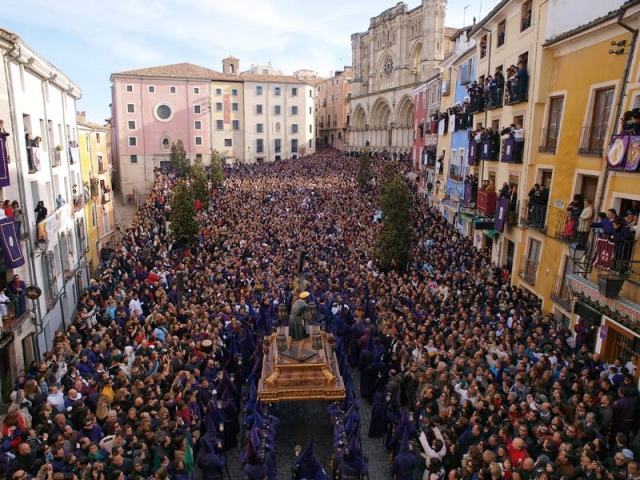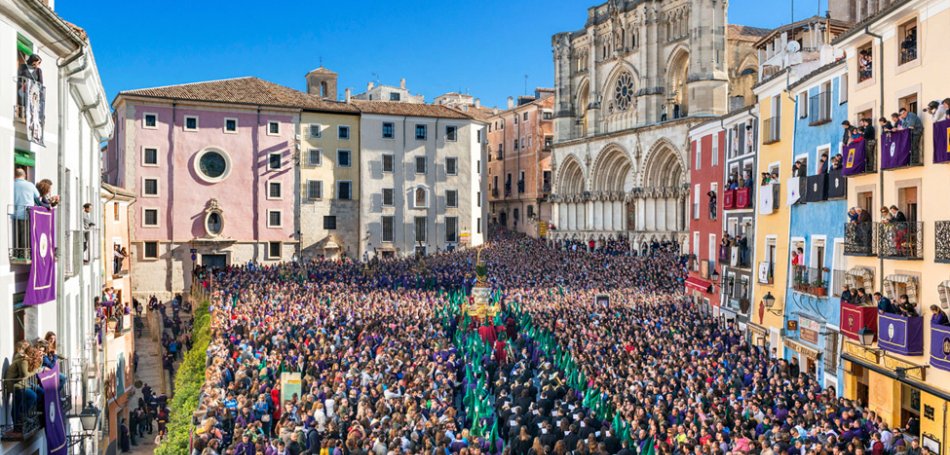
- publicado 22.03.2023
- por Cuenqueando
- Semana Santaholy weekUNESCOWorld Heritage City
10 Ideas to enjoy Holy Week in Cuenca
If you don't know how to enjoy Easter in Cuenca, in this post we give you 10 ideas with possible plans to travel during Easter in the province of Cuenca. This year it falls from April 2 to 9 and how many of you have started to ask us about the "essentials" here you have them, always at our discretion and leaving us cool plans without mentioning (Cuenca has a Holy Week that lasts a month) , the plans that you cannot miss.
1. Cuenca, the Nazarene city
The city of Cuenca is one of the most beautiful places to go on a trip at Easter. It is not for nothing that it has the title of UNESCO World Heritage City, it is one of the 15 most beautiful cities in Spain. But as if this were not enough, its Holy Week is classified as of International Tourist Interest, year after year, it becomes the scene of the representation of the Passion, Death and Resurrection of Christ.
The streets of Cuenca are flooded with robes, green, purple and black hoods, drums, silence, merriment... Cuenca is Holy Week, it is feeling and it is tradition. More than thirty brotherhoods are involved throughout the year so that Holy Week in Cuenca is an international benchmark.
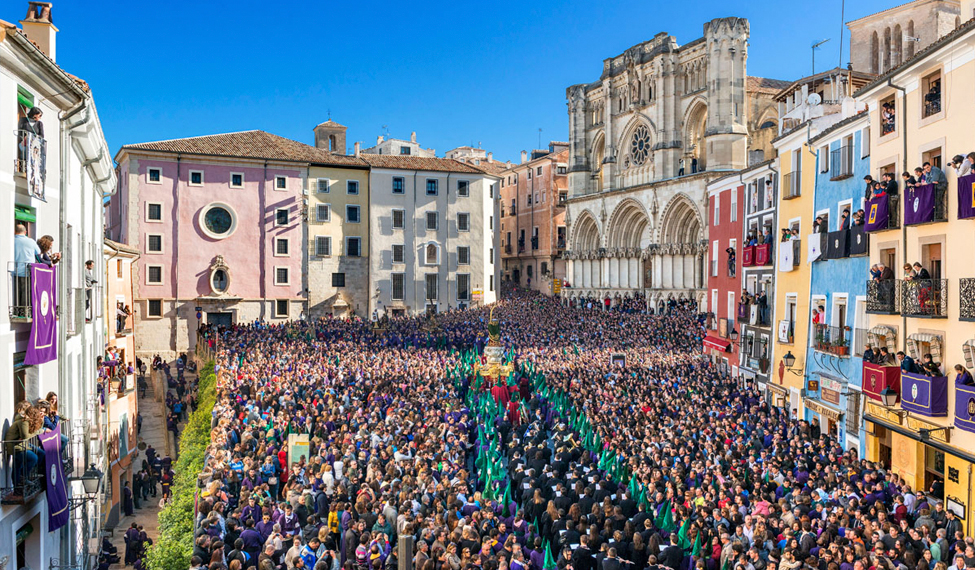
2. Friday of Sorrows in Cuenca
The Friday before Palm Sunday is celebrated on Friday of Dolores, within the Catholic tradition the sufferings of the Virgin Mary are commemorated. The Bible collects 7 pains:
- 1 Pains: the presentation of the Child Jesus
- 2 Pains: flight to egypt with baby jesus
- 3 Pains: Jesus is lost in the Temple
- 4 Pains: encounter with Mary on the way to Calvary.
- 5 Pains: the crucifixion of Christ
- 6 Pains: descent from the cross
- 7 Pains: burial of Jesus
On this day in the city of Cuenca one of the most affectionate acts is celebrated, and that is that the people of Cuenca accompany the Mother of Sorrows in their pain in her Hermitage. Within the framework of the Júcar river gorge is this place of special veneration, a small hermitage with privileged views where, since the 14th century, the carving of the Virgen de las Angustias awaits, the current one is from 1942, the work of the image maker Luis Marco Perez.
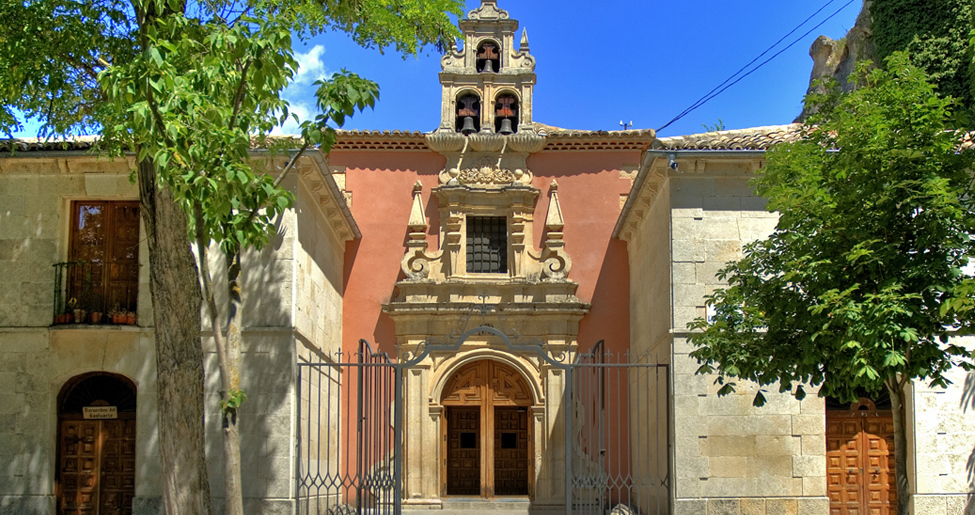
3. Religious Music Week
It is the fourth oldest music festival in Spain, and has been declared of International Tourist Interest. This year the SMRC celebrates its 60th edition, this festival turns Cuenca year after year into the international epicenter of liturgical, mystical and spiritual music. Its settings are monumental spaces, such as the church of San Pablo or that of San Miguel; the most outstanding figures of ancient music worldwide have passed through them.
The 60 SMR program will offer great Spanish orchestras such as RTVE with Christoph König, ORCAM with Marzena Diakun, Real Filharmonía de Galicia; prestigious national artists such as the pianist Eduardo Fernández and international artists such as the British vocal ensemble Stile Antico. The festival is not only located in the city of Cuenca, but will also have appointments in Cardenete, Belmonte or Arcas. Also accompanying the festival are master classes, lectures and a commemorative exhibition.
.jpg)
4. Las Turbas procession in Cuenca
The Turbas have become one of the hallmarks of Holy Week in Cuenca. The Camino del Calvario procession leaves at dawn on Good Friday, popularly known as the Turbas, it represents the mockery that Jesus suffered on the way to Golgotha. The "turbos" are linked to the Real, Illustrious Ancient and Venerable Brotherhood of Nuestro Padre Jesús Nazareno del Salvador, but in this procession, following the Turbas, the brotherhood of San Juan Evangelista and closing the brotherhood of Our Lady of loneliness.
The first thing that attracts attention is the clothing of the turbos, who instead of wearing the armed hood, wear it tied around their necks with their faces uncovered, and carry a drum in mourning or a bugle. During the early morning, the Plaza del Salvador fills up with turbos that await the moment of departure. At 5.30 the doors of the Church of El Salvador open in an overwhelming moment, between the deafening sound of drums and bugles, the Jesus appears (the script or flag with the shield of the brotherhood) followed by the passage of Verónica (Jesus fallen and Verónica), behind him continues the merriment with the image of San Juan "el guapo". Suddenly, everything is silence, respect and tradition when the script of the Brotherhood of Nuestra Señora de la Soledad appears followed by the passage of the Encounter and the image of Nuestra Señora de la Soledad de San Agustín.
We can tell you about it, but you have to be there to live that moment, that mixture of faith, magic and passion that this overwhelming procession contains.
5. Lux in Tenebris in the Ucles Monastery
Lux in Tenebris is a mystical and avant-garde art and music festival that takes place at the Uclés Monastery, in Uclés (Cuenca) between April 14 and 17. It is a reinterpretation of the liturgical celebrations of Holy Week that aims to evoke the mystique of these acts from all the arts.
An ambitious program made up of various unpublished shows combining music, theater and audiovisual narrative. During the four days that the festival lasts, various proposals are offered, each one with a different musical personality. The concert of the Office of Darkness will offer an unprecedented "duel" between the two great composers of the Spanish Renaissance: Tomás Luis de Victoria and Cristóbal de Morales. The enigma of the Sepulcher interprets the time that elapses between the death and resurrection of Christ. To involve all the senses in this experience, La Cena de Vigilia becomes a performative show fusing tradition and innovation by designer Andrea Santamarina and chef Domingo Sánchez, from Casa Palacio.
And to close Lux in Tenebris, the Concert of Joy will be held on Sunday by the Community of Madrid Orchestra and Choir, which will perform Beethoven's 9th Symphony.
 .
.
6. Holy Week in Tarancon
Holy Week in Tarancón has been declared a Festival of Regional Tourist Interest. It is celebrated from Palm Sunday to Resurrection Sunday, with processions and Stations of the Cross every day of the week.
Its history dates back to the year 1815, the date on which the brotherhood of the Holy Burial was founded, and it was not until 1943 when it merged with the Brotherhood of the Blessed Virgin of Soledad. In 1954 the Board of Brotherhoods was born, as the governing body of the Taranconera Holy Week.
The silences, the bands, the tunics, the hoods... all of Tarancón is wrapped in a unique atmosphere that makes this tradition a unique experience.
7. Living passion of Tarancón
The Living Passion of Tarancón is celebrated in the evening of Holy Saturday. The historic center of Tarancón becomes the Jerusalem of the last days of the life of Jesus of Nazareth. Since 1991, this staging has brought to life the characters of the Passion and Resurrection of Christ. In 1995 it was declared a Festival of Regional Tourist Interest in Castilla-La Mancha.
At 8:00 p.m. on Holy Saturday, the parade of the Roman century begins on Miguel de Cervantes avenue, starting La Pasión. From there you walk through the streets of Tarancón to the Plaza del Ayuntamiento to finish at the Church of the Assumption, if you do not know its altarpiece it is one of the Jewels of Cuenca that you cannot miss.
The representation consists of different scenes:
- Triumphal Entry of Jesus into Jerusalem (Town Hall Square)
- Meeting with the Sanedritas (Town Hall Square)
- Healing of the Blind (Town Hall Square)
- Dinner Preparations (Town Hall Square)
- Last Supper (Town Hall Square)
- Gethsemane Prayer, Kiss of Judas and Arrest (Plaza de la Solana)
- Judgment of Caifás (Plaza del Caño)
- Denials of Pedro (Plaza del Caño)
- Trial of Pilatos (Plaza del Caño)
- First fall and Simon of Cyrene (beginning of the Cuesta de la Iglesia)
- Encounter with Mary (end of the Cuesta de la Iglesia)
- Veronica (Constitution Square)
- Second fall and hanging of Judas (Plaza de la Constitución)
- Comfort the women of Jerusalem (Constitution Square)
- Third Fall (Plaza de la Constitución)
- Crucifixion (Plaza de la Constitución)
- Burial (Church road)
- Resurrection (door of the Church)
- Ascension (door of the Church)

8. Living passion of Motilla del Palancar
For almost 30 years on Holy Saturday in Motilla del Palancar the Passion and Death of Our Lord Jesus Christ has taken place. This tradition began thanks to a group of children and young people from catechism who began representing in their church the sacramental play of Manuel Muñoz Hidalgo Cántiga to the passion of Our Lord Jesus Christ.
That day, more than 200 people participate in this tradition, becoming soldiers, Romans, Jews, disciples... A Holy Week full of devotion.
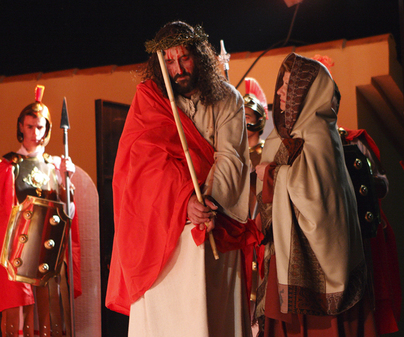
9. The Chozo in the Herrumblar
Every year on Easter Sunday a tradition is celebrated in this town of La Manchuela de Cuenca. A meeting takes place in which the main protagonists are the fifth and fifth of the year, the young people who come of age. This tradition dates back to when men were going to do their mandatory military service and it was celebrated as a farewell party.
The Chozo, which is how it is known, consists of the fifths and fifths decorating a street in the town with arches lined with tree branches and flowers made of tissue paper by the women of the town. At the end of that street is the shelter or hut where the baby Jesus is. The Encuentro procession takes place, the fifths bring the Virgin from the church and in the middle of the street the encounter takes place in which the mourning for the Virgin is removed.
10. Torrijas y resolí
And it is that if we talk about tradition we cannot leave out one of our favorites: the French toast and the resolí. Two of the typical sweets of Holy Week. The origin of the French toast is not clear, but nobody seems to care where this tradition comes from to be able to seize it as their own, and it is that nobody is bitter about a sweet. What is clear that when it smells of incense in the churches in the kitchens of many Cuenca homes smells of French toast. We are fans of French toast in all its forms, whether they are the traditional ones soaked in wine or milk, or those with violet caramel or black beer.
What we Conquenses do aim for is the traditional resolí with which to accompany any traditional sweet these days. Resolí is a typical liquor from Cuenca, which you surely have in your memory because it is often sold in a clay bottle in the shape of the Hanging Houses of Cuenca. Do you want to prepare a resolí? These are the ingredients of its traditional recipe: natural ground coffee, water, brandy or anise liqueur, orange peel, lemon peel, cloves, anise seeds, cinnamon and sugar. On the one hand, prepare the coffee and on the other, caramelize the sugar, mix and add the rest of the ingredients, let it cook for 1 hour, cool, strain and add coffee liqueur... and you have it !

 ES
ES EN
EN PT
PT
